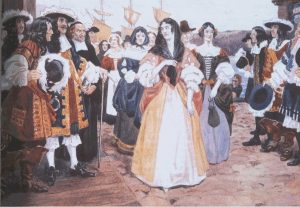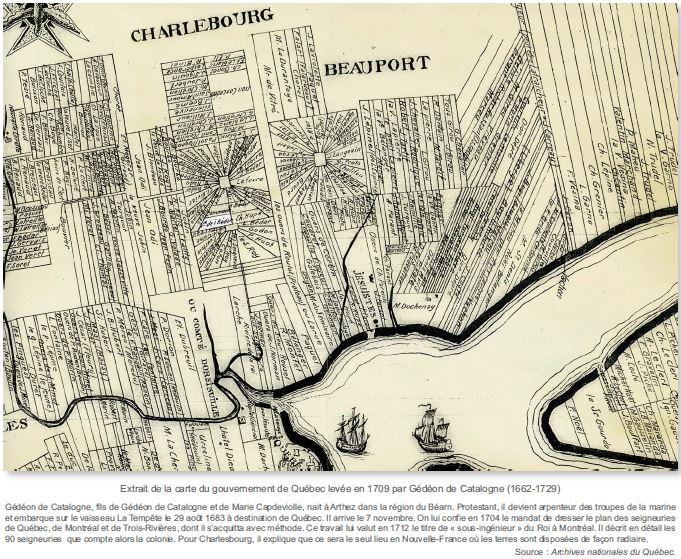History of Pierre Toupin & Mathurine Graton

The Arrival of the French Girls at Quebec, 1667 by Charles William Jefferys /
Library and Archives Canada (fonds/c010688k) PD
Mathurine Graton
Born in about 1648 (or 1651) in Aubigny, a town a little southwest of LaRoche-Sur-Yon, in the diocese of Luçon, in Poitou, France. She was the daughter of a royal notary of the seigneurie of Aubigny, Pierre Graton, and his wife Marie Boucher.
After the deaths of her parents, Mathurine left for New France at about age 18 (or 22) in 1670. Her brother Claude Graton, sieur de Villefort, his wife Marguerite Moncion (Mossion) and their children also made the voyage to New France that summer, probably on the same ship. Claude Graton and his wife Marguerite are said to be the ancestors of all the Gratons and Grattons in North America. While in New France, Claude and Marguerite had a son, Joseph.
At the time of her arrival in New France, Mathurine was considered both a minor and an orphan, her parents being deceased. It was likely she had fallen on hard times financially. Mathurine is considered to be a fille du roi. The program of the filles du roi (or King’s Daughters) was sponsored by King Louis XIV and instituted by his Minister Colbert and involved some 770 marriageable women (out of a possible 1,000 originally) who survived the hazardous journey across the Atlantic between 1663-1673 to marry a single man in New France and settle and raise a family. Some, but not all, filles du roi received a dowry from the King and sometimes this fact was noted in the bride’s marriage contract.
Pierre Toupin dit Lapierre
Born in about 1626 in Rouffiac, in the archdiocese and diocese of Angoulême, in Angoumois (Charente), France. Pierre was the son of Guillaume Toupin and Jeanne Arnault. The town of Rouffiac no longer exists, its last mention having been made before the French revolution.
Pierre arrived in New France on June 30, 1665 at age 38 as a soldier in the La Brisardière company, which had been detached from the Orléans regiment and made part of the Carignan-Salières regiment sent to New France by King Louis XIV. Pierre and his company, including another of my ancestors Pierre Balan, had departed La Rochelle, France on February 26, 1664, under the command of Alexandre de Prouville, the Marquis de Tracy. The LaBrisardière company and three other companies are said to have driven the Dutch out of the Antilles and re-established law and order for the French colonists there.
Thereafter on June 30, 1665, Sieur de Tracy and his 200 troops (including Pierre) arrived at the town of Québec. They joined the Carignan-Salières regiment, whose twenty companies landed in several ships directly from France earlier that month or during the following months, for a total of some 1200 troops. Apparently Pierre Toupin wintered in the town with his company.
There were two separate “Toupin” ancestors who settled in New France in the 17th century: Toussaint Toupin dit Du Sault, who arrived in about 1634 and whose descendants are known as “Toupin” or “Dussault; and Pierre Toupin dit Lapierre. It appears that none of Pierre’s descendants are known as Lapierre, which was a “dit” name (or nickname) by which he was listed on the roll of Carignan soldiers (as was common for soldiers at the time).
Following his arrival, the combined Carignan-Salières regiment engaged in military campaigns against the Iroquois (Haudenesaune) confederacy, mostly against the Mohawk (Kahniakenhaka) who had not already sued for peace as had other Iroquois nations during 1665-66. By 1667 this campaign accomplished King Louis XIV’s goal of pacifying the Iroquois, who had been attacking the French settlements, and brought some 30 years of peace to the region for the French (and must have wrecked havoc on the affected Mohawk communities) This peace, aided by the marriages of the filles du roi with single male occupants of the colony, allowed the French population in the colony to expand at long last.
It is not known whether Pierre Toupin directly participated in battle but he was discharged from the military in 1668 and accepted the King’s offer to the soldiers to settle in Canada, as did some 400 of the soldiers and officers from the regiment. In New France, a man of modest means could become a land owner, a nearly unthinkable feat back in France at the time. On December 10, 1668 a concession of land was granted to Pierre by Joseph Giffard, the seigneur in Beauport, as recorded by notary Vachon. This land was in the parish of Beauport, in the village of Saint-Michel, on the north shore of the St.-Lawrence river, just east of the town of Quebec, and it was where Pierre spent the remainder of his life as a farmer.

Map of Beauport and environs, 1709.

Closeup of map of Beauport area and land of Pierre Toupin dit Lapierre and son.
On September 30, 1670, Mathurine married Pierre Toupin at the Catholic church in Beauport with Father Henri Nouvel, SJ presiding, and with Joseph Giffard and Noel Langlois as witnesses. Notary Vachon had drawn up the marriage contract on September 3, 1670, which the couple were not able to sign but agreed to.
Pierre was age 43 at the time of the marriage, and Mathurine was only between 18 and 22 years of age. The census in New France in 1681 showed that Pierre, age 55, and his wife, age 33 (from which her year of birth was estimated), had the first four of their eventual seven children of their own, named Thérèse, age 10, Pierre, age 8, René, age 5, and Louise, age 2, along with Pierre, listed as a “domestique,” age 13. The ages and other information found in censuses from that era are often contradicted by the actual church records of baptisms and other events, so a researcher must be wary. Pierre Toupin was listed in the census as having two guns, nine cattle, and about 30 acres of developed land; thus, the couple had achieved much in their 11 years together by that date.
As noted, Pierre and Mathurine eventually had a total of seven children. Their first, Thérèse (1671-1760), married in 1689 but apparently had no child. Their second, Pierre, born in 1673, was a “coureur des bois” and is said to have disappeared after 1710 on a trip to Detroit; he left no known descendant. Their third child René (1674-1758), a blacksmith, married Geneniève Langlois in 1708 and had 12 children and many descendants in later generations in both Canada and the United States.
In 1698, Louise-Renée (1680-1703), their fourth child, married the Royal Notary Jacques Barbel, who served as secretary to the Intendant Begon of New France, and had three sons (all died young). Ignace (1684-1748), the fifth child, married Marie-Elisabeth Duprac in 1709 and had 11 children and many descendants. The sixth child, Marie-Anne, died at age two months. The seventh child, Jean-Baptiste, born 1688, was the last child of Pierre and Mathurine and is a direct ancestor of their great-great-great-great grandson Felix Toupin who married Josephine Bissonnette in 1893 in New Hampshire. Felix and Josephine are my great-grandparents.
Jean-Baptiste Toupin was born in Beauport on November 20, 1688, when his father was 61 years old. Jean-Baptiste became an edge-tool maker and blacksmith. He settled in Champlain, near Trois-Rivières, at the age of 30. There he married Thérèse Caron on April 2, 1719. On February 6, 1743, he became the Seigneur of the Lapierre (no relation) Seigneurie in Cap de la Madeleine by purchasing the rights from Françoise LeSieur. Jean-Baptiste and Thérèse had at least four children.
In addition to raising their own children, in 1674 Pierre and Mathurine took on the added responsibility of guardianship of four of their five Graton nieces and nephews following the death of their sister-in-law Marguerite Moncion in June 1674. Claude Graton is thought to have returned to France in either late 1671 or early 1672, and apparently he never returned to Canada, leaving his wife Marguerite and their five children. One child, Hélène Graton had married in 1673; but four were unemancipated, with Renée Graton marrying in 1683 and Joseph Graton (born July 1672) marrying in 1697.
Ancestor Pierre Toupin died in Beauport at about 75 years of age, and was buried there on January 28, 1703. A commemorative plaque can be seen at the Beauport cemetery today, with the inscription “L’Ancêtre Canadien, Pierre Toupin dit Lapierre, fils de Guillaume et de Jeanne Arnoud, originaire de Rouffiat, évéché d’Angoulême, un des pionniers de Beauport, fut inhumé ici le 28 janvier 1723 (sic).” In fact, he died and was buried in 1703.

Commemorative plaque to Pierre Toupin, Beauport, QC.
Photo by Gisèle Toupin.
Mathurine remarried to Vincent Brunet, also of Poitou, France, on July 22, 1710. He was born in about 1645. The couple signed a marriage contract on June 22nd before notary Chambalon. They did not have a child. Apparently Mathurine died on February 5, 1728, at the age of 76 or more. Vincent lived until 1736.
Researched & Written by David Toupin, great-grandson of Felix Toupin.
References
La vie quotidienne en Nouvelle France, by Raymond Douville and Jacques Casanova, 1964; translated by Carola Congreve as “Daily Life in Early Canada”; the MacMillan Co., New York, 1967.
Dictionnaire généalogique des familles du Québec des origins à 1730; by René Jetté, 1983
Dictionnaire national des Canadiens français, 1760-1935, by Institut Drouin
Dictionnaire généalogique des familles Canadiennes, 1621-1765, by Msgr. Cyprien Tanguay, 1870-1877
Nos Ancêtres: Pierre and Jean Toupin, c. 20, by Jacques Saintonge, translated by Thomas Laforest as “Our French Canadian Ancestors”, the Lisi Press, 1989
The Good Regiment: The Carignan-Salières Regiment in Canada, 1665-1668, by Jack Verney, McGill-Queens University Press, 1991
The King’s Daughters, by Elmer Courteau and Joy Reisinger, 1988
Les filles du roi: Orphélines en France, pionnières au Canada, Leméac Editions Inc., Montréal, 1992
L’Ancêtre Claude Graton, sieur de Villefort, et sa famille, by Bertrand Desjardins et Nicole Marcil-Gratton, Mémoires de la société généalogiques canadienne-française, vol 44, no. 3, pp173-181
King’s Daughters and Founding Mothers: the Filles du Roi, 1663-1673, by Peter J. Gagné, Quintin Publications, 2001.
